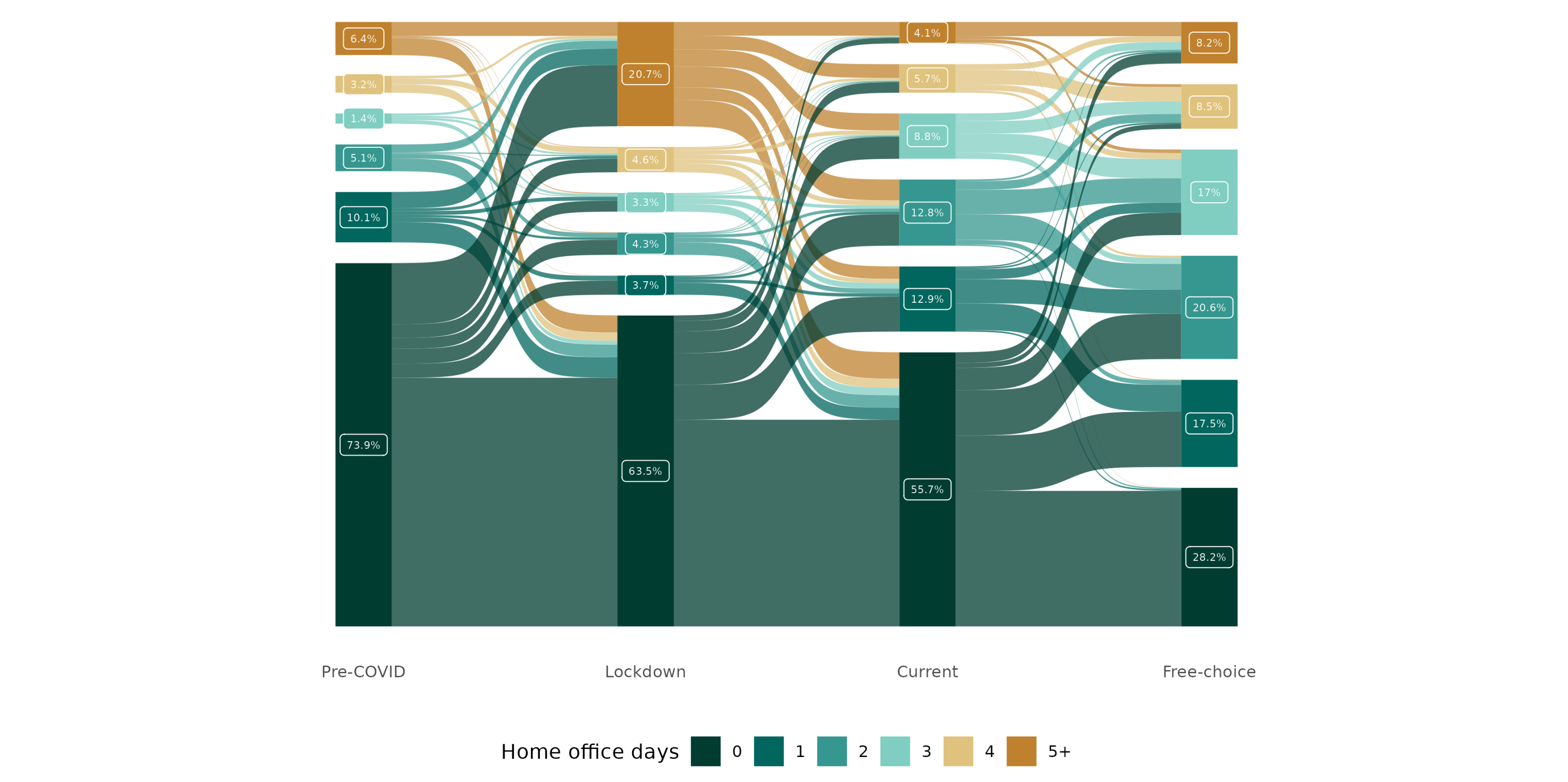Multimodality in the Swiss New Normal, new insights and evidence released under the recently concluded Mobility Initiative project
The team composed by Daniel Heimgartner, Aurore Sallard and Milos Balac from Kay W. Axhausen's chair investigated the mobility behavior in a new normal, characterized by a large population share adopting working from home.

Evaluating the impacts of working from home on urban transportation can help assess the potential environmental benefits, such as reduced emissions and improved air quality, induced by the potential reduction of travel time and shift towards more sustainable transport modes. Further, different network loads could potentially require a reassessment of the transport infrastructure.
When a large share of the workforce adopts home-office, transport demand might be affected via several channels. The most obvious one is teleworkers not commuting. However, more indirect effects might play a role too.
We hypothesize that the main leverage influencing the new transport equilibrium is threefold:
- The population share having access to hybrid work forms and wanting to work remotely.
- The home office population reconsidering mobility tool ownership, and
- their possibly different activity patterns than the regular workforce.
The dataset to understand work from home preferences in Zurich and surroundings
As part of this work, a unique dataset was collected, tailored to elicit work from home (WFH) preferences and resulting changes in mobility tool ownership (MTO) such as owning a vehicle or public transport season ticket. The addresses were drawn from a stratified sample of the German-speaking part of Switzerland, from the address registry of the Federal Statistical Office. Respondents were invited to answer an online questionnaire asking about socioeconomic characteristics, the residential environment, home office situation, as well as work-related and mobility-related topics. Subsequently, people in the workforce and eligible to work from home were invited for an additional survey eliciting on their preferences concerning work from home and mobility tool ownership.
What the data revealed, and the methodology used to derive resulting mobility patterns
The team observed a shift from very high home office frequencies (during the pandemic) to two or three days (after the pandemic). Meanwhile, home office access remains at high levels (47%) suggesting that employees who have gained access to the new work form during the pandemic are still (partially) working from home. From an employee perspective, the current situation does not constitute an equilibrium: A large portion would like to increase WFH frequencies, in particular, the population currently not having access (potentially reducing the share not working from home to roughly 30%). Generally, Mondays and Fridays are the preferred weekdays to WFH. The team computed the population share working from home on any given weekday and under alternative frequency scenarios. The previously alluded additional potential shift yet to come has considerable leverage, increasing the home office shares across weekdays substantially. This also highlights that an understanding of what constraints this free-choice (such as hybrid work policies) matters.
Statistical models explaining who wants to work remotely on how many days as well as how this choice is linked to reassessing mobility tool ownership was then integrated into the travel demand synthesis pipeline (eqasim) of the multi-agent transport simulator (MATSim) for the case of Zurich.
The team designed strategies that represent different realistic ways in which the population can adapt their behavior when they are working from home. One of them is based on the TimeUse+ survey (a unique app-based travel diary fielded after the COVID-pandemic) and the other is based on adaptations of the mobility patterns as reported by the microcensus. Both changes in the performed activities and changes in activity locations were investigated.
The strategies are simulated on an average weekday and Friday as the latter has empirically much higher home office shares and is therefore expected to constitute an edge case. They found that while the chosen strategy seems to have minimal to negligible effect on the results, the simulated day has a major impact.
Conclusions
A substantial reduction in the number of trips is achieved, especially during peak hours, while the mode shares remain stable. Home office adoption ultimately seems to improve traffic conditions for motorists suggesting that congestion on major commuting axes could be substantially reduced.
Additionally, the research results provide evidence against off-setting rebound effects, which are found by other studies in the literature. The authors of the present study demonstrate a general reduction in the number of trips and travelled distances across all modes and throughout the day.
Home office therefore can be an effective policy lever to improve network conditions and
attenuate any negative traffic-induced externality. Further, it does not distort mode preferences and therefore, the infrastructure does not need to be readjusted.
-

Daniel Heimgartner (Institute for Transport Planning and Systems, ETH Zurich) -

Aurore Sallard (Institute for Transport Planning and Systems, ETH Zurich) -

Milos Balac (Institute for Transport Planning and Systems, ETH Zurich)
Daniel Heimgartner, worked in this project from the very beginning, he comments on the challenges he had to overcome:
“This work delved into a question of systemic consequence. The transport system is complex as a multitude of dimensions shapes the transport equilibrium. At its core stands human behavior. Home office can impact this behavior in several ways and investigating underlying decision processes is not easy. As a consequence, a simple question such as How does home office impact the transport equilibrium? results in a set of smaller questions which all need to be answered first. There is a trade-off between the substance of a question and the precision one can answer it. For example, in our work, we needed to understand the activities people perform during home office and how far they differ (in terms of activity type, location choice, scheduling, etc.) from a regular office workday. Only this question could fill the scope of a doctoral thesis. In this work, we were forced to strike a balance between heuristics and rigor. We said: We do not understand the activity patterns precisely, let’s test different scenarios and check how far the results are driven by our assumptions. This balance between substance and precision, assumptions and rigorousness, was not always easy.”
For Daniel, a surprising outcome was, that people seem very attached to their mobility tools and subscriptions despite the potential lifestyle changes implied by working from home. Both mobility tool ownership and modal splits do not change dramatically.
“Defining research questions that are attractive to all the project partners as well as feasible from an academic point of view (and given the project scope) was pivotal.” An advisory group was composed and they regularly met to brief and exchange on the current project state.
Comment from SBB
"For the Swiss Federal Railways (SBB), the findings presented in the report on Multimodality in the Swiss New Normal are highly relevant in understanding the impact of home office on mobility behavior in Switzerland. With a significant portion of the population adopting remote work, it is crucial to assess the implications for transportation systems, environmental sustainability, and infrastructure planning. The insights provided by this research can guide decision-making processes, inform policy development, and support sustainable and efficient transportation planning, both within SBB and the transport system as a whole. The collaboration between SBB and ETHZ has once again proven successful, which allows us to directly import part of the research outcome into our transport modeling environment."

“The collaboration between SBB and ETH Zurich once again has proven to be successful, and this allows us to directly import part of the research outcome into our transport modeling environment.”Joshka Bischoff, Product Owner of SIMBA MOBi - SBB's multimodal Transport Simulation"
